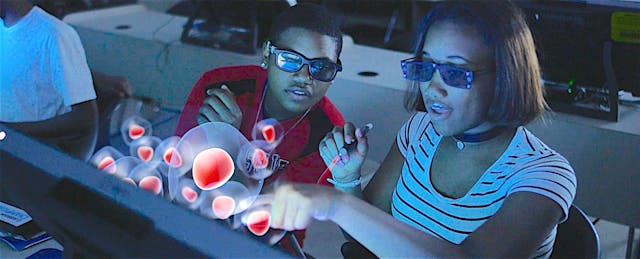Imagine a high school student in your district. Her class is learning about muscles, but instead of watching a video or reading about it in a book, she can move a virtual arm and see an exposed bicep muscle contract. Are engines her thing? She can safely experiment with a virtual torque wrench in a mechanics class. It sounds powerful, doesn’t it? Not to mention effective.
Michael Carbenia thinks so. That’s one of the many reasons the Director of Career and Technical Education (CTE) for Florida’s St. Lucie Public Schools has worked tirelessly to add augmented reality (AR) and virtual reality (VR) technology to his CTE classes over the past 12 months.
Formerly known as vocational and technical classes, CTE programs like St. Lucie’s are increasingly viewed as a pathway to provide students with the hands-on skills industry and businesses say they need in new employees. For students, the real-life experiences gained using AR—where digital information overlays their actual surroundings—and VR—where they are completely immersed in a digital setting—are captivating.
Carbenia’s experience has made him an invaluable source of knowledge when it comes to adding AR and VR to CTE classes. He’s well-versed in how the technology can save districts money, why it boosts students soft skills, and has experienced firsthand how it can guide and prepare students for the workforce of the future.
EdSurge chatted with Carbenia, who shared tips on selecting, implementing and funding the technology—along with a deeply relevant lesson he learned from his family.
EdSurge: How have AR and VR impacted students and learning in your district?
Michael Carbenia: AR/VR in CTE allows me to have one single device where we can expose many more kids to different career options. In one day—in the same classroom—we can dissect an elephant, weld a beam, take apart a car, and dissect a human. I can cover that with one student or multiple students in 30 minutes. Without AR/VR it would be very expensive for me to provide all of these various models.
With AR/VR in our classes I see students—especially the millennials, generation Zs—finding that the education system is keeping up with technology, and that I think keeps them coming.
Why did you decide to add AR and VR to your CTE program?
It was twofold. We saw that local employers—as well as employers on a global scale—are putting tremendous value in AR/VR and we wanted to explore it. And we are socially and globally now acknowledging that college is not the only way. I want our students to know there are other pathways to success, other career options.
On a more personal note, one of my family members dropped out of high school. And one of the greatest things I’ve learned from him is when he was in the classroom decades ago, he was highly intelligent, but the teaching models just didn’t engage him. He would go home and take apart car engines, and build forts, but school wasn’t enough for him. A lot of what sent him down the wrong path was because he lost value and lost interest in school because there were no hooks for him.
When I showed him AR/VR, the first thing he said was, “If I had that, who knows where I’d be.” That’s just powerful for me. We talk about that a lot, and I try to bring that knowledge to my work. If AR/VR gets one more kid into the classroom and eventually in a successful career, it’s worth every penny and every investment of my time or the teacher’s time.
How did you choose the right system for your district?
Employers talk a lot about how millennials lack soft skills, how this generation doesn’t know how to interact with people. I wanted our school system and our students to meet the needs of our community, but I didn’t want kids to be locked into tunnel vision in a headset. I want them to be sitting next to each other, dealing with issues and questions together in a safe and controlled environment.
So, we did an internal study of what is out there, what would be a good fit, what kind of industry-supported curriculum was available, what gives us the most utility. And through that process, we landed on zSpace.
There’s a fluidness that can happen in a classroom with zSpace’s platform. Students put on glasses, not headsets—and that allows for true, immediate interactions. If we’re looking at a human body using zSpace, we’re all looking at it together. That can’t happen if students have headsets on.
zSpace combines elements of AR and VR on a desktop computer with a suite of apps that help students explore and interact with 3D objects. How is it set up in your schools and how did you decide where to use it?
I have 20 zSpace units at two high schools being used for CTE—ten apiece—and then I have ten dispersed through three K-8 schools being used for things like makerspaces.
We are a Title I district. We’re more than 75% free and reduced lunch. We are demographically almost split evenly at 33% Caucasian, 33% African-American, 33% Hispanic. So it really wasn’t about the type of school. It was about who really wanted to dive in and learn this new way of teaching.
I took some time and just sat down and talked to the teachers. Through that process, people naturally weeded themselves out because they were intimidated by the process, or they were excited.
I found the most success implementing in classrooms with teachers who are eight to 12-year veterans and need something to energize them. After being in a standard classroom for so long, AR/VR can spark excitement.
What is the financial impact on your district?
It’s had a major impact on my budget. In our medical academies, for example, there’s a cost for EKG leads and all those consumables, and students typically will practice that 50 times. Now, instead of practicing it 50 times on a human, they can do 45 on the zSpace machine, and then I only need them to really practice five times on a human because they’re getting the repetitions.
The same could be said with the robotics pieces and parts—before they would often disappear and vanish. Now, I can have a student practice building his robot four or five times and then go really put it together. They get to go through that whole scientific process and hypothesize, and create, and make adjustments, and then build it.
How does AR and VR prepare students for future careers?
I’m a big Malcolm Gladwell fan and he talks about how it takes 10,000 hours of practice to be considered a master at something. The students now are getting those repetitions. They’re getting exposures to so many different things that [used to require] the wood shop, or home economics or the automotive lab.
Now they can do those things in a much faster, more efficient, and—best of all—extremely accurate way because so much of this content is created with support from the industry. They’re getting the accurate training they need, and I think that puts them at a huge advantage over a student who is still doing it the traditional way.
We also want to prepare our students for jobs that don’t exist yet. We want them to have some fundamental skills they’re comfortable with, and I believe working in a virtual reality environment is one of those skills.
What funding tips do you have for other districts interested in adding AR and VR to their CTE programs?
Ask, ask, and ask again. Ask anyone who cares about education and has a passion for technology.
Hopefully you’re using your professional network. For me, ACTE is a great resource—being a member of that family and just reaching out and saying, ‘Guys, I’m looking for grants.’ Whether it’s Bill and Melinda Gates or the federal government, there is money there.
I have also found networking at conferences like ACTE, ISTE, FETC or FACTE to be fruitful—talking to peers across the country has taught me many ways to fundraise.
And every state has a Carl Perkins grant, which is our federal money towards Career and Technical Education. Tapping into that is a great way to fund your programs. That’s hundreds of millions of dollars that our federal government is pouring into CTE. Whether you’re post-secondary or secondary, you have access to that money.
Michael Carbenia's favorite VR content
- VR Automotive Expert—“Having access to the program allows students to practice safely before they go in there and start pulling things apart.”
- VIVED Science—“In our Vet-prep academy students are dissecting animals and increasing their depth of knowledge before they transfer into our high school veterinary program and began live surgeries.”
- Human Anatomy Atlas—“Students can watch all of the body's muscle movements in real time and watch the body change.”
- Leopoly—“Students are allowed to build and create in a digital sandbox connected to a 3D printer and then print the objects they have created.”



